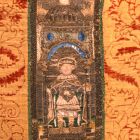
Back of a chasuble - with Saint Stephen and Saint Ladislaus
| Materials: | silk yarn; silver-gilt thread; velvet (lanciered) |
|---|---|
| Techniques: | metal thread raised embroidery; padded metal-thread embroidery |
| Dimensions: |
length: 122 cm
width: 70 cm
|
The pattern is typical of the early Renaissance textile designs made in Florence in the 1480s. It forms an undulating vertical line of thick boughs with large pomegranates on them, and scattered smaller pomegranates around. Paraments of similar fabric have been found in large numbers in the churches around Florence and Pistoia. Variations of the same pattern can be found in numerous collections, and they are usually looked upon as being the work of Florentine, Genoese or Spanish workshops. A piece identical with the one exhibited is in the Prato Museo del Tessuto (cf. Bonito Fanelli 1975, No. 8. - Florence, late 15th century). The vertical line of the embroidered orphrey shows the Madonna and Child, St. Stephen and St. Ladislas and a later destroyed, figure of St. Emeric, in an arched background. On the horizontal line are busts of St. Jerome and St. Augustine. Ruth Grönwoldt describes these liturgical embroideries with one or three domes as Venetian, or influenced by Venetian models, mainly on the basis of comparative studies in late quattrocento and early cinquecento Venetian painting. (Grönwoldt 1965, pp. 231-240). The chasubles found is Hungary that show the same motifs were registered by Mária Csernyánszky as "cum cruce venciana" on the basis of the Pauline Inventory of Budaszentlőrinc (1532). The chasuble with only one dome ("Miracoli") is Hungarian, modelled on Venetian pieces. There is a similar chasuble depicting figures of Hungarian saints in the Esztergom Treasury (Inv. No. 1964.299).
Literature
- Szerk.: Farbaky Péter: Hunyadi Mátyás, a király. Hagyomány és megújulás a királyi udvarban 1458–1490. Budapesti Történeti Múzeum, Budapest, 2008. - Nr. 10.22. (László Emőke)
- Szerk.: Pataki Judit: Az idő sodrában. Az Iparművészeti Múzeum gyűjteményeinek története. Iparművészeti Múzeum, Budapest, 2006. - Nr. 42. (László Emőke)
- Szerk.: Kőszeghy Péter: Magyar Művelődéstörténeti Lexikon. Középkor és kora újkor. Balassi Kiadó, Budapest, 2003 - 2014.
- Szerk.: Mikó Árpád, Sinkó Katalin: Történelem - kép. Múlt és művészet kapcsolata Magyarországon. Magyar Nemzeti Galéria, Budapest, 2000. - Nr. II.9. (László Emőke)
- Szerk.: Pataki Judit: Művészet és Mesterség. CD-ROM. Iparművészeti Múzeum, Budapest, 1999. - textil 35.
- Szerk.: Péter Márta: Reneszánsz és manierizmus. Az európai iparművészet korszakai. Iparművészeti Múzeum, Budapest, 1988. - Nr. 36. (László Emőke)
- Szerk.: Voit Pál, László Emőke: Régiségek könyve. Gondolat Kiadó, Budapest, 1983. - p. 314., 7. kép
- Szerk.: Miklós Pál: Középkori miseruhák. Az Iparművészeti Múzeum gyűjteményei. Magyar Helikon, Budapest, 1979. - 329-352. (Szilágyi András)
- Csernyánszky Mária: Kaseln "cum cruce veneciana". Ars Decorativa, 6. (1979). Iparművészeti Múzeum, Budapest, 1979. - 11-38., Nr. 2.
- Szerk.: Radocsay Dénes, Farkas Zsuzsanna: Az európai iparművészet remekei. Száz éves az Iparművészeti Múzeum. Iparművészeti Múzeum, Budapest, 1972. - Nr. 47.
- Szerk.: Voit Pál, Csernyánszky Mária: Az Iparművészeti Múzeum mesterművei. 1896-1946. Iparművészeti Múzeum, Budapest, 1946. - p. 5.
- előszó: Végh Gyula: Régi egyházművészet országos kiállítása. Iparművészeti Múzeum, Budapest, 1930. - Nr. 444.
- Szerk.: Csányi Károly: Az Országos Magyar Iparművészeti Múzeum gyűjteményei - az iparművészet rövid történetével. Iparművészeti Múzeum, Budapest, 1926. - 131.kép

